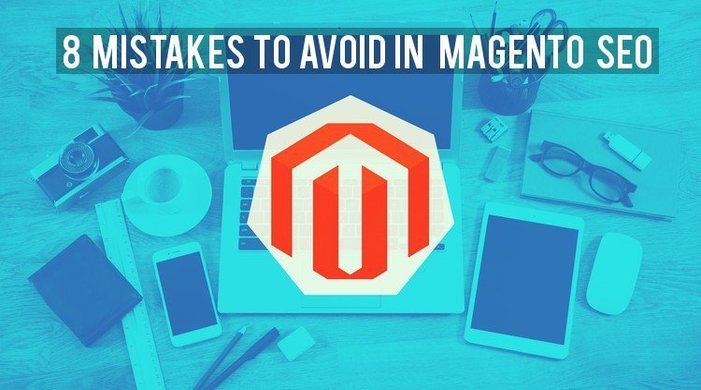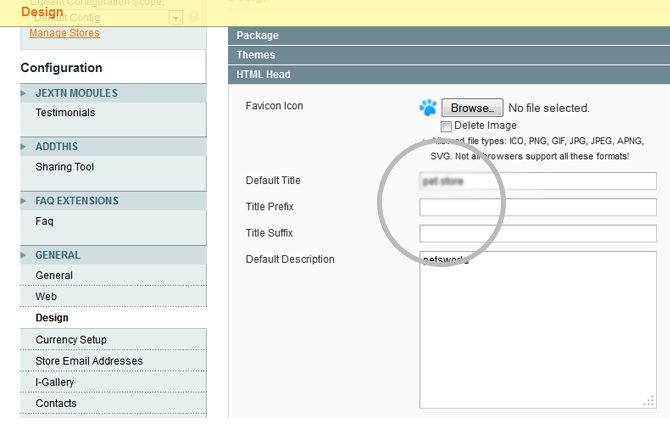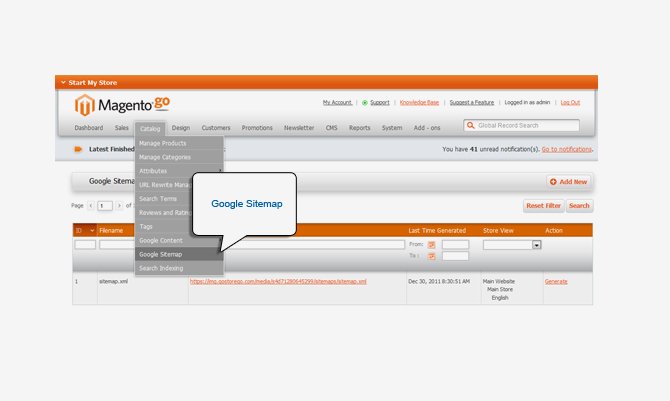Our Offices
USA OFFICE
937, Shore Point Court, # G313,
Alameda - 94501, California, USA.
INDIA OFFICE
C - 81C, Sector - 8,
Noida 201301, UP


Magento is the one and only platform which is dominating the ecommerce market with 26% share winning clear leadership amongst all other hosted as well as licensed shopping cart solutions. It already powers more than 1,50,000 online businesses across the globe and this is the reason why more and more new entrepreneurs are investing in this giant platform and are looking to hire experienced Magento developers. But sadly, not all who have their stores up and running succeeded in lifting sales, making a strong impression on search engines and are under pressure to deliver targeted customers traffic and conversions. So in this article, I decided to spot the 8 common SEO mistakes committed by most of the ecommerce businesses and suggested possible solutions in an endeavour to increase your sales and conversion Rates. In case you missed my previous article on Magento SEO – Top 5 SEO tips to skyrocket your ecommerce sales, go read it now.
Forgetting to change default settings with Title Tag is the biggest mistake that kills your chances to show up in the search engine result pages (SERP). I have come across many SEO folks who optimize the title tags but tend to do so in a completely wrong way. Here the most common mistake I have often found is the website’s Homepage title as “Home” which is absolutely unacceptable and rather I would say that it doesn’t make any sense. Instead, the title should be something which directly represents your business and reflects its services or products. Say, for example – If your store sells shirts online in India, a relevant title could be “Shirts | Buy Shirts for Men and Women Online in India at Best Price”. If you have hired good SEO experts for your SEO campaigns, you will probably not see this blunder being done on your ecommerce website. So here, I would strongly suggest you to not take any risk with your traffic and get the best optimization for your ecommerce site to rank top in the search engine results.
Apart from the one listed above, I have jotted down other 4 mistakes that are often committed with title tags:
Suggested Solution:
Go to your admin area,
System – Configuration – Design – HTML Head
and enter a new title in the “Default Title” field. Make sure that the title you create is keyworded, descriptive, absolutely unique and relevant to your own store, what you sell or deal in. Fill out the default description field as well with unique content and best keywords that are 100% relevant to your business. Remember to choose only the logically meaningful phrases for your keywords instead of nonsense copy pasted stuff. Don’t forget to limit your title to 60 characters and your descriptions to maximum 160 characters.
Below I have attached an image for you to understand better.

I have seen many SEO companies optimizing alternate title texts for all product images but unfortunately most of them forget to change this for the logo, thus hurting the SEO part. For changing the alt text for your logo, do as directed below
Go to System – Configuration – Design, click on Header tab and change the logo source to your respective filename or path and here you can change the alternate text of your logo as well. Again I suggest using the search engine friendly filenames and good keyworded text for the alt text of your logo.
I have seen many search engine optimizers committing this mistake deliberately and they proudly argue by saying that Mat Cutts – the Spam Leader at Google has informed in 2009 that Google doesn’t use the keywords metatag at all. Yes, I do agree that search engines ignore the keyword meta tag because of the rise in spamming issues and that they tend to focus more on the visible text. But not changing the default keywords is also painful from SEO lens. Here what I mean to say is don’t focus on keywords, instead focus on high quality logical phrases that make up Best Keywords. The keywords that you craft for your website should be unique and meaningful to avoid a bad experience.
Suggested Solution:
Leave the Default keywords field blank if you have not yet decided the keywords for every product page, category page and CMS page otherwise Google will index these default keywords and you will be in trouble. While choosing keywords, you can even take help from many free Keyword tools that are present on the web.
Go to System – Configuration – Design – HTML head – Default Keywords and change the default keyword setting by either leaving it blank for some time or inserting your own keywords if you have carefully analysed them.
For example, you have a company that manufactures Ruby stones so instead of using the whole company name as keyword, you can use something like – “Ruby Stones from Gala – Fashion Manufacturing”
Having Duplicated URLs is another big blunder for ecommerce search engine optimization. What it exactly means is having a redundant URL in the webpages.
Suggested Solution:
To solve the duplicacy issues in your URLs, go to
System – Configuration – Catalog – Search Engine Optimization
and assign “No” to the field “Use Categories Path for Product URLs”.

Despite Google sharing a pretty good overview on how to deal with canonicalization issues in its content guidelines posted at Webmasters Tools Support Page, a large no. of search engine optimizers and even the professional SEO agencies commit the mistake of not handling canonicalization at all.
Suggested Solution:
Go to System – Configuration – Catalog – Search Engine Optimization
and at the bottom set the following 2 fields to “Yes”. This not only handles your canonicalization issues but it will also prevent the auto generation of duplicated content whenever you want to show the same product in multiple categories

URL rewrites are also known as search engine friendly URLs that are very crucial part for SEO. They make your URLs easier to read by both search engine crawlers and visitors.
Suggested Solution:
Go to your admin panel and change the following default settings as suggested below:
Layered Navigation is also a big problem for Magento SEO but at the same time missing this part while designing Magento ecommerce site is also a blunder for sales because every visitor who is browsing products on your site would love to find the desired product within seconds and can get irritated if he/she doesn’t see any layered navigation widget to filter the products by price, category , size or color. For those who don’t know what exactly I am talking about, see the image shared below that well describes what layered navigation is.

This type of navigation attracts many issues of identical content. Plus, it messes up all your URLs, page titles and descriptions with duplicate content which again ends up killing all your SEO efforts.
Suggested Solution:
Don’t allow your layered navigation pages being indexed by Google. This can be done via cookies or sending fast Ajax Requests. Using Ajax navigation will enable your visitors to filter your featured products without appending anything to URLs and ending up at the original page only. But again, to achieve this is a hard nut to crack and you will have to hire experienced Magento Developers to do this for you. Alternatively, you can even purchase and integrate a Premium Extension – Layered Navigation Pro from Magento Ecommerce extensions library.
This is the biggest mistake due to which your website looses all worth as it instructs search engines to go away and not pay any attention to your online shop. This mistake is often not committed deliberately and many ecommerce development companies just forget to turn it on while switching from development stage to live stage.
Suggested Solution:
Before launching your website live on your server, don’t forget to turn meta robots on through “index,follow”
To do this ,Go to your admin panel and scroll to
System – Configuration – General – Design – HTML Head – Default robots “INDEX, FOLLOW”
Or if you want to directly do it in code, i.e. in your robots.txt file, change the attributes as follows
meta name=”robots” content=”INDEX,FOLLOW”
Remember, you have to do this only after you are completely done with the development of your store and would like to switch to live server. Don’t do this in your development stage and instead you need to set it as “NONINDEX, NOFOLLOW” while you are on your testing server.
For those who are not aware of this, let me tell that in Magento Language, sitemaps refer to ‘Google Sitemaps” and this doesn’t mean that they are supported only by Google and not the other search engines. Yes, they are supported by Yahoo!! and Microsoft’ Bing as well. I have seen a lot of SEO folks forget including sitemaps and if they do, they don’t refresh it at regular intervals. Many of them even build it including sample products and categories and later they forget to check it and remove before going live.
Suggested Solution:
Step 1 – Add a sitemap by creating one from the sitemap directory in your web root along with writable permissions.
Step 2 – If you are using “Magento Go” – the hosted version of magento, simply Go to Catalog- Google Sitemap tab as shown below.

Or if you are using the normal version, go to System – configuration – Catalog – Google Sitemap and create one for your site.
Step-3 – Set up your Magento store such that it automatically refreshes your sitemap at regular intervals. To configure this functionality, go to your admin area,
System – Configuration – Catalog- Google Sitemap
You can also download some premium custom sitemap extensions like Magento Extended Sitemap Extension and Aschroder.com Sitemap Submit
So, these were the most common mistakes that I could compile from my experience of optimizing tons of high ranking Magento Ecommerce sites. I hope you all will keep them in your Magento SEO checklist and will evolve your SEO strategy by learning from these mistakes. If you would like to challenge us by giving us a chance to optimize your Magento ecommerce site as well, contact TIS India to get an affordable quote and let’s get started.
Subscription Implies Consent To Our privacy Policy
7 Reasons Why Internet Marketing Is Important For Your Business
The 10 Advantages of Using WordPress for Developing Business Website